|
|
THIRD INDUSTRIAL MASTER PLAN (IMP3) 2006 - 2020 Year : 2006 |
THEME
Malaysia - Towards Global Competitiveness.
OBJECTIVE
To achieve long-term global competitiveness through transformation and innovation of the manufacturing and services sectors.
SCOPE
- Covers manufacturing sector, including agro-based industries, and non-Government services sector.
- 12 industries in the manufacturing sector have been targeted for further development and promotion. Among them, six are non-resource based and the rest are resource based industries:
Non-resource based:- electrical and electronics;
- medical devices;
- textiles and apparel;
- machinery and equipment;
- metals; and
- transport equipment
Resource based:
- petrochemicals;
- pharmaceuticals;
- wood-based;
- rubber-based;
- oil palm-based; and
- food processing.
- Eight non-Government services sub-sectors have been targeted for greater development and promotion:
- business and professional services;
- distributive trade;
- construction;
- education and training;
- healthcare services;
- tourism services;
- services; and
- logistics.
- Identification of targeted industries and services based on their potential in growth and exports.
TARGETS
- Manufacturing Sector
- to grow at 5.6 per cent annually and contribute 28.5 per cent to gross domestic product (GDP) in 2020; and
- total investments of RM412.2 billion (RM27.5 billion annually).
- Non-Government Services
- to grow at 7.5 per cent annually and contribute 59.7 per cent to GDP in 2020; and
- total investments of RM687.7 billion (RM45.8 billion annually).
- External Trade
- exports to increase to RM1.4 trillion in 2020; and
- total trade to increase to RM2.8 trillion.
- Productivity
- total factor productivity (TFP) to grow at 2.6 per cent annually; and
- contribute 41.4 per cent to GDP during the IMP3 period.
STRATEGIC THRUSTS OF IMP3
- Enhancing Malaysia 's position as a major trading nation:
- intensifying exports of targeted growth areas;
- developing and promoting Malaysian brands;
- enhancing exports through compliance with international standards; and
- nurturing domestic companies, including GLCs and SMEs, to become globally competitive.
- Generating investments in the targeted growth areas:
- promoting investments and exports of products and services with growth potential;
- facilitating capable domestic companies, including GLCs, to expand into potential growth areas;
- establishing fully equipped specialised high technology parks;
- encouraging multinational corporations (MNCs) to establish and expand operations in Malaysia ; and
- providing a more conducive investment environment.
- Integrating Malaysian companies into regional and global networks
- encouraging industries to focus on core competencies and strengths within regional and global networks;
- undertaking outsourcing, off-shoring and other forms of business practices; and
- developing Malaysia as a regional hub for selected products and services – halal , biotechnology and automotive.
- Ensuring industrial growth contributes towards equitable distribution and more balanced regional development
- Equitable Distribution
- promoting Bumiputera Commercial and Industrial Community (BCIC) through new sources of growth in manufacturing and services sectors and outward investments;
- enhancing the development of Bumiputera human capital; and
- enhancing the growth and increasing ownership of BCIC through the development of SMEs.
- Balanced Regional Development
- promoting more balanced industrial development in lesser developed states; and
- encouraging integrated logistics industry.
- Equitable Distribution
- Sustaining the contribution of the manufacturing sector to growth:
- accelerating the shift towards higher value-added products and activities and high technology and capital-intensive activities;
- encouraging the development and promotion of 12 targeted industries; and
- facilitating the development of domestic and regional clusters.
- Positioning the services sector as a major source of growth:
- strengthening the efficiency and competitiveness of the sector;
- enhancing the development and promotion of 8 targeted services sub-sectors;
- developing regional centres for education, distribution, health and tourism services;
- creating greater links with manufacturing; and
- undertaking progressive liberalisation.
- Facilitating the development and application of knowledge-intensive technologies
- fostering collaborations among Government research institutes, institutions of higher learning, science and technology parks and industries;
- promoting research-based industrial cluster development; and
- promoting the greater utilisation of ICT and other technologies along the value chain.
- Developing innovative and creative human capital:
- matching the supply of talents and expertise with market requirements;
- increasing the supply of technically skilled, knowledgeable and ICT-trained workforce;
- encouraging collaboration between training institutes and industry to optimise the utilisation of resources and facilities; and
- creating a critical mass of local experts in scientific and engineering fields to meet R&D requirements.
- Strengthening the role of private sector institutions:
- encouraging companies to become members of trade and industry associations;
- encouraging the establishment of Malaysian trade and industry associations overseas; and
- facilitating private sector institutions to undertake capacity building and trade and investment promotion, and providing common-user facilities for members.
- Creating a more competitive business operating environment:
- ensuring the efficiency and effectiveness of the delivery system;
- reviewing rules and regulations to facilitate the growth and expansion of existing and potential industries and services;
- ensuring greater transparency of policies, rules and regulations; and
- implementing a efficient paperless trade facilitation system.
|
|
STRATEGIES AND POLICIES |
STRATEGIES AND POLICIES FOR SPECIFIC AREAS
Apart from 10 overall strategic thrusts, IMP3 contains strategic thrusts and policy measures for specific areas:
- External trade;
- Investments;
- Development of SMEs;
- Branding;
- Growth areas in the manufacturing sector;
- Growth areas in the services sector;
- Development of the halal industry;
- Enhancing domestic capabilities;
- Human resource requirements;
- ICT and other technology developments; and
- Logistics.
Last Updated 2015-07-14 08:40:57 by Azuna Hasbullah atau Abd Rahman













 Home
Home
































